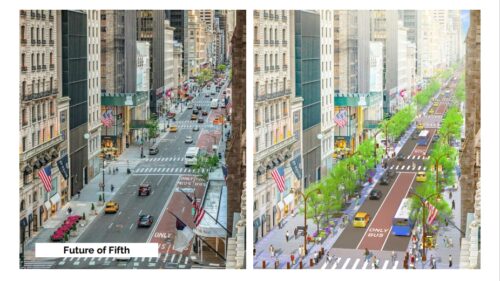
A slide from Ya-Ting Liu’s CityLaw Breakfast presentation.
By Mark Chiusano
Ya-Ting Liu was appointed New York City’s inaugural chief public realm officer two years ago this month. How has the realm changed so far during her tenure?
That was the subject of Liu’s talk at New York Law School’s 196th CityLaw Breakfast on Wednesday, during which she described well-used public space as “the secret sauce of cities” and how she thinks pedestrians should be “the main character” in New York City design. Liu, whose position is based in the office of the Deputy Mayor for Operations, Meera Joshi, outlined several big public space infrastructure projects and policies the city is advancing, and pitched the importance of her team’s role in coordinating the many stakeholders involved.
The city has created 84 football fields of public space in the last three years, she noted in her presentation, arguing that building and improving space on that scale is no minor win. Liu — who has a background in both the private and advocacy sectors through stints at the rideshare company Via, the nonprofit Transportation Alternatives, and other organizations — started the government gig as the city was emerging from the COVID-19 pandemic, when much concern was being aired about an urban “doom loop” that could threaten New York City as workers went remote or moved away. Her position was among the recommendations of a blue-ribbon panel assembled by Mayor Adams and Governor Hochul and tasked with figuring out how to make the city more desirable for business, workers, residents, and visitors while improving the economy.
For Liu, the motto is that if public space can be built, people will come. “Whenever you create a little, tiny space for pedestrians, people vote with their feet pretty quickly, and that little space gets filled,” she said.
Among the “priority” capital projects the city is exploring are nine acres of space under the Manhattan side of the Brooklyn Bridge (The Arches / Gotham Park) and transforming 20 blocks of 5th Avenue from Bryant Park to Central Park into “a world-class pedestrian boulevard” lined with trees and double-width sidewalks. That midtown effort is an example of some of the synergies that can come from public space upgrades. Pedestrians and local businesses would benefit, but so would efforts by the Department of Environmental Protection to bring essential underground infrastructure into the 21st century. “Because the pipes under 5th Avenue are almost 200 years old,” Liu explained, and in need of critical work. If the city is talking about ripping up the streets and sidewalks to modernize the bustling commercial-heavy strip, then this becomes an opportunity to also give the area the full upgrade it needs.
Another project, the Queensway, which would transform part of an abandoned railway into the “High Line of Central Queens,” includes over $100 million in federal funding, which Liu says is safe despite the Trump administration’s slash-and-burn reentry to DC. “We got the federal government and the grantee to sign the paperwork, to sign the check, so we’re secure that this part of the funding is in place,” she said.

Ya-Ting Liu speaks at the 196th CityLaw Breakfast. Image Credit: CityLand.
Liu described her unit as a “central quarterback team” focused on public realm issues, approximately “five or six of us” within Joshi’s larger team, which has itself been coordinating the city’s efforts to secure billions of dollars of competitive federal infrastructure grants. Her work includes reducing red tape for outside partners like Business Improvement Districts and conservancies who do programming and maintenance for many public zones in the city.
Joshi, Liu, and company are also pushing policies related to public space, such as reforms to a local law that requires buildings to be inspected every five years. It has an overhead consequence that is very noticeable to New Yorkers, Liu said: “That really is the generation of, the source of creating a lot of scaffolding.” She said the Adams administration is working to advance legislation already introduced in the City Council to create “more sticks” for building owners who keep scaffolding up longer than necessary.
Liu also previewed legislation meant to address app delivery companies and the e-bikes and mopeds used by their workers. The conversation over those speedy micro-mobility devices has largely been about enforcement on the workers, Liu said. “And part of what we’re feeling is that there’s a core business model here that is incentivizing speed.” The legislation would create new licensing and accountability requirements for the companies.
Liu also addressed public space issues that can be very difficult for government to control, like public restrooms. “I don’t think we’re going to be able to build our way as a city out of this problem,” she said. She pointed to other solutions for this longstanding challenge, like incentivizing businesses to open up their restrooms to the public — one of several times where she referenced trying to learn from other global cities that have advanced solutions to thorny public livability issues.
The restroom fight is a good example of how hard it can be to manage public space in New York, where every inch of sidewalk and curb space has some “20 other competing needs for it,” especially in dense commercial areas. “The increasing demands on our street space, that is the most contested, hotly in-demand real estate,” Liu said. “And it’s finite.”
Liu closed by sharing advice former Deputy Mayor Dan Doctoroff gave her upon taking the public realm job that she said has stuck with her as she has tried to advance priorities within what can be unwieldy and often slow-moving city government: “you have to act with both urgency and patience.”
*****
Mark Chiusano is a Senior Fellow in New York Law School’s Center for New York City and State Law and the author of The Fabulist: The Lying, Hustling, Grifting, Stealing, and Very American Legend of George Santos.

